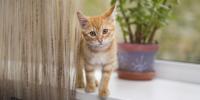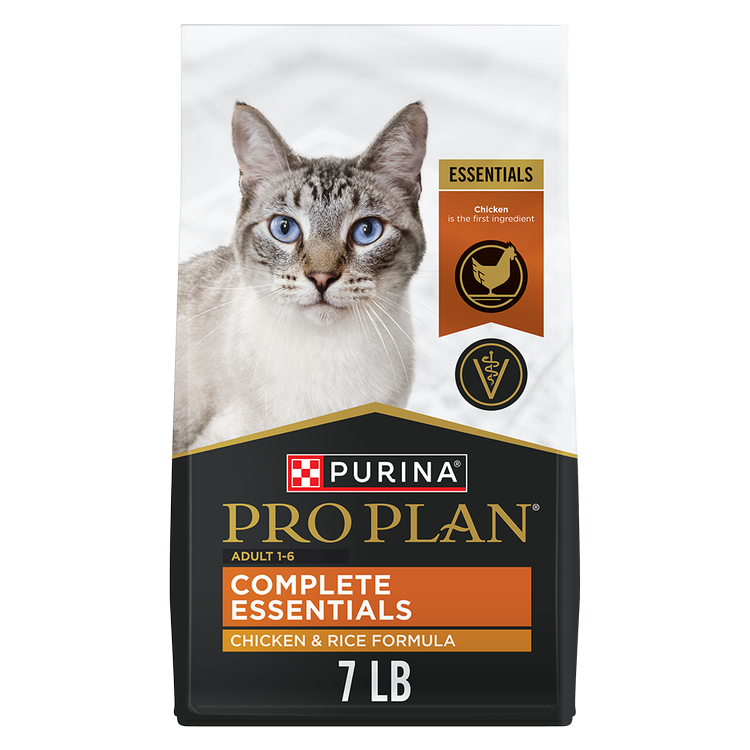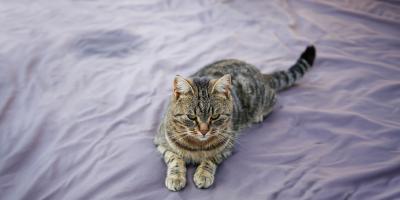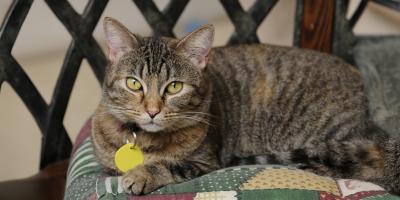Why is My Cat Twitching in Their Sleep?


There’s nothing cuter than watching your cat peacefully sleep, and then twitch or curl their tail out of nowhere. They might even let out a tiny meow. These sleep behaviors, including cats twitching in their sleep, are normal and common, although they might leave owners wondering what’s going on in their cat’s head. Here we explain why cats twitch in their sleep, what it means, and when you should be concerned about cat twitching.
Why Do Cats Twitch and Jerk When They Sleep?
Cats are notoriously good sleepers, clocking an average of 12 to 16 hours a day. They go through different sleep stages just like humans. However, unlike humans, who have one long sleep period overnight, cats have multiple short sleep sessions throughout the day and night. This is called polyphasic sleeping.
A cat’s sleep cycle consists of REM (rapid eye movement) and non-REM sleep, just like a human. During non-REM sleep, cats sleep lightly. During cat REM sleep, they are in a deep sleep, and they could even be dreaming. REM sleep happens during about a quarter of a cat’s total sleep time.
What is Normal Cat Twitching in Their Sleep?
During REM sleep, it's perfectly normal for cats to make small movements no matter what cat sleeping position they are in, like flopping tails or small meows. These can include:
- Whisker twitching
- Ear flicking
- Paw movements, as if they’re batting toys
- Tail movement, such as swishing or thumping
- Facial expressions
When your sleeping cat makes these movements, they are likely also rapidly moving their eyes, deep in REM sleep. Some active cat breeds, like the Siamese or Abyssinian, might display more notable sleep movements during REM sleep.
Kittens also tend to move more in their sleep than adult cats. This might be because their nervous systems are developing, and they have a higher percentage of REM sleep as they grow.
Difference Among Sleep Twitching, Tremors, and Seizures
If your cat is twitching while sleeping, it is usually harmless, but there are some instances where it might indicate a more serious condition, such as sleep twitching, tremors, or cat seizures:
- Sleep twitching: This is when cats gently move in their sleep. It stops when the cat wakes up. This is usually because they are deep in REM sleep. Kittens or growing cats might do it more than adult cats.
- Tremors: Uncontrollable shaking that happens while asleep or awake is called a tremor. This can affect one specific body part, such as their paws, or the whole body. You should call your vet if your cat is shaking in their sleep and you suspect tremors.
- Seizures: Cats with seizures will demonstrate full-body convulsions. They could also lose consciousness or urinate or defecate uncontrollably. Call your vet immediately if you believe your cat is having a seizure.
What to Do if Your Cat is Twitching in Their Sleep More Than Usual
In some cases, your cat’s jerking could be a sign of stress or anxiety, neurological issues, toxin exposure, pain or discomfort, or metabolic issues.
If you notice an increase in your cat's sleep twitching, pay attention to:
- The frequency and intensity of the twitching or jerking
- Any changes in sleep behavior or patterns
- Their behavior when they wake up
- And other symptoms like lethargy, changes in litter box habits, or a loss of appetite
Your veterinarian may recommend tests to rule out underlying health issues.
Good Cat Sleep Habits
Cats that jerk or twitch in their sleep are often healthy, and twitching is just a natural part of their sleep habits. To ensure your cat gets quality sleep:
- Provide a safe sleeping area. Every cat should have a quiet, warm spot to call their own, such as a cat bed or blanket.
- Keep a consistent routine. Regular feeding and play times can help regulate your cat’s sleep cycles and allow them to know what to expect every day, which can make them less anxious.
- Engage in daily playtime. Cats are seen as low-maintenance compared to dogs, but they also need mental and physical stimulation. Play sessions can help tire a cat out and promote better sleep.
- Consider pheromones. Some cats respond well to certain scents, which can help create a calm environment that relaxes them enough to get into a deep sleep.
- Keep the litter box clean. A dirty litter box can be stressful and potentially disrupt sleep cycles. Anxious cats may also sleep in the litter box, so keep your eyes out for this behavior.
Conclusion
Twitching is a normal part of sleeping for cats, and it means they are comfortable enough to get into a deep sleep. It’s harmless for cats to jerk, meow, or move in their sleep. However, if there are tremors or seizures present, you should consult your vet immediately.
For more expert tips on cat behavior, explore our other understanding cats articles.
Frequently Asked Questions About Cat Sleep Twitching
Should I Worry if My Cat Twitches?
Most healthy cats will twitch in their sleep, sometimes. If the twitching is frequent, steady, intense, or comes with other symptoms, call your vet.
Why is My Cat’s Face Twitching in His Sleep?
Facial twitching of their cheeks, noses, whiskers, mouths, or eyelids is also normal and might mean that they are dreaming. Your cat might even meow in sleep. Your cat’s ear twitching in sleep is also a normal behavior.
Is it Normal for My Cat to Be Meowing in Their Sleep?
Occasional sleep-meowing is normal. If your cat is meowing constantly in their sleep, it might mean they are in pain. You should consult a vet if you suspect this to be the case.
Related articles

Earn myPurina Rewards with Every Purchase
Use your points for treats, toys, and gift cards with myPurina app.






